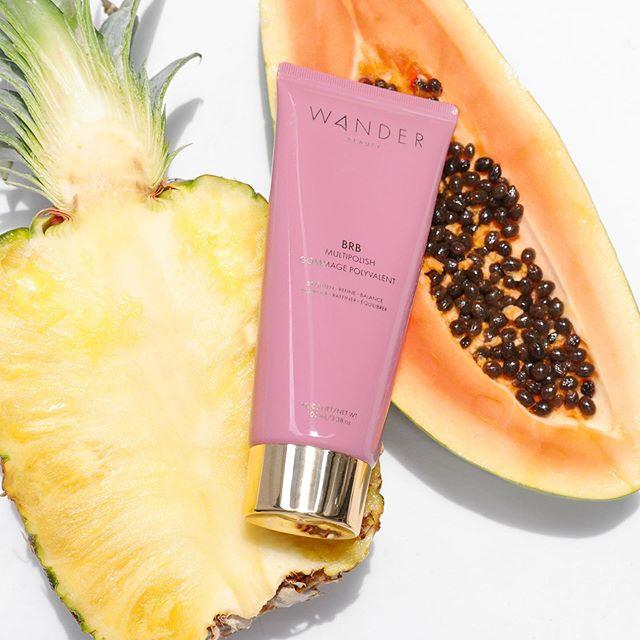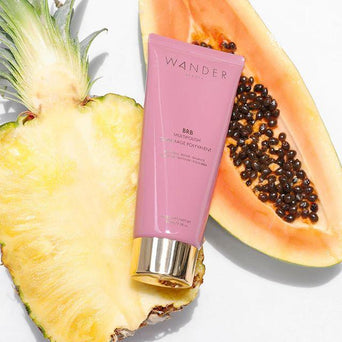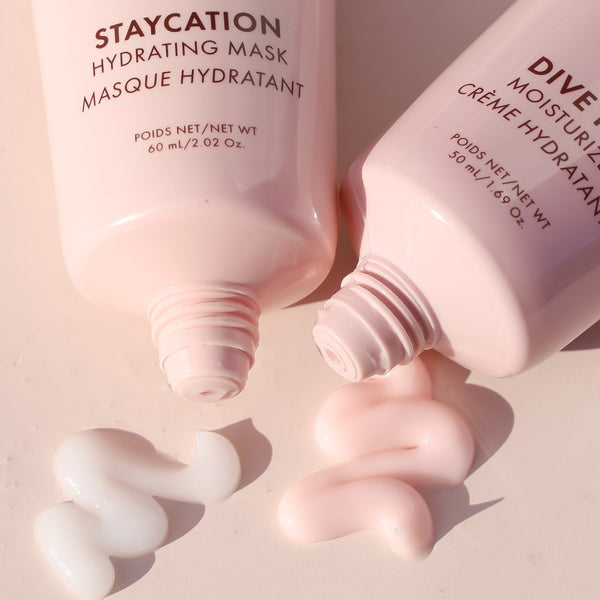Beauty Basics: Manual Exfoliation vs. Chemical Exfoliation
By Emily Chiang | Jun 03, 2019
“I love dead skin buildup,” said no one, ever. Exfoliation, which is the removal of dry/dead skin cells on the surface of your skin, is the key to achieving radiant, glowing, and more youthful looking skin. It is best to exfoliate one to two times a week to unclog pores and maintain a smooth complexion.
Maybe you've shied away from exfoliation because of how harsh it may sound (we all know that some exfoliating ingredients have become controversial recently). Or maybe you're of the camp that can't get enough of the satisfying process of exfoliation. But we're here to debunk both camps: Did you know that you can exfoliate your skin two ways? Yup, you can exfoliate both manually (or physically) and chemically. There are benefits to both methods but it is important to remember that no matter which method you choose, don’t over-exfoliate!
Ready for the full beauty basics breakdown of exfoliation? Keep reading!
What is manual exfoliation?
Manual exfoliation involves any formula that contains tiny grains to physically scrub your skin clear of debris. You can manually exfoliate with your hands, or with tools like a brush or a textured sponge. There is something so satisfying about a good face scrub. The massaging action stimulates blood circulation so your cheeks look rosy and your face looks like it is glowing and smooth.
A common misconception about exfoliating is that the harder you scrub/exfoliate, the better. This is false! Don’t scrub too hard: There is no need to apply an excess amount of pressure since the tiny grains work wonders just by being rubbed on your skin gently. If you’re too rough while exfoliating, it can leave your skin irritated and exposed to bacteria and possible infections. Keep in mind, if you have sensitive skin, you can control the intensity of the exfoliants you use on your face.
Benefits of manual exfoliation:
- Stimulates circulation - helps to reduce facial puffiness
- Will not interact with the ingredients in the rest of your skincare regime
- Immediate results
We love using BRB Multipolish, which is a super fine face and lip exfoliator (you can even use it on your body) that contains pineapple and papaya enzymes to gently exfoliate away dead skin and helps improve the appearance of scars for brighter looking skin. Your skin, lips and body will instantly feel smoother and softer after use!<product>1</product>
What is chemical exfoliation?
Chemical exfoliation involves the use of gentle acids in low percentages to remove dead skin cells off your face. Be careful mixing topical treatments like retinols/retinoids with an exfoliator. This could lead to redness, irritation, and flaking. Common chemical exfoliators will have AHAs or BHAs. AHAs (Alpha Hydroxy Acids) are best if you have skin concerns revolving around sun damage, uneven texture and pigmentation. BHAs (Beta Hydroxy Acids) are best if you have concerns about blackheads, enlarged pores and milia.
Benefits of chemical exfoliation:
- Requires no scrubbing
- Works more deeply than a physical exfoliant
- Helps to reduce signs of aging
For chemical exfoliatiing, we love Fast Lane Instant Facial. It is an advanced AHA/BHA packed exfoliating mask that works to quickly resurface skin with a high impact combination of 10% AHA and 2% BHA revealing a brighter, more youthful looking complexion instantly.<product>2</product>
Is it possible to use both?
Yes! It is definitely possible to use both manual exfoliation and chemical exfoliation. However, do not use them one day after another. It is best to give your skin a break between uses to avoid over-exfoliation. If you have never exfoliated before, we have created a sample schedule of what your skincare could look like with exfoliation being incorporated into the routine. Of course, skincare is unique to each individual so tweak the routine to cater to your personal skin needs.
Why should you exfoliate?
There are so many benefits to exfoliating whether you do it manually or chemically. Exfoliating regularly helps to:
- Get rid of dead skin cells to increase cell turnover
- Cleaning away the dead skin keeps fresh and healthy cells at the surface while removing the dry and dead skin cells. As a result, your skin looks more radiant, glowy, and youthful.
- Unclog pores and prevent acne. Unclogging your pores helps to prevent whiteheads, blackheads, and acne. It is a great way to help prevent breakouts. Keep in mind that you should not over-exfoliate to prevent acne because that will result in a whirlwind of problems including but not limited to, dehydrated skin, inflammation, and redness.
- Evens skin tone and texture
- Getting rid of dry and dead skin while improving skin texture is great for those who struggle with dark spots, hyperpigmentation, and acne scars. Exfoliating regularly smoothes texture which makes skin appear more uniform.
- Helps the other beauty products in your skincare routine penetrate deeper. Dead skin builds up over time which makes it difficult for your skin to properly absorb your skincare products. By unclogging your pores and getting rid of the layer of dead skin, the products in your skincare regimen are able to penetrate deep into your skin and work to its full potential.
How to exfoliate
We suggest that you exfoliate 1 to 2 times a week and avoid anymore than that! Over-exfoliating can lead to microtears in your skin which can result in redness, inflammation, and exposure to bacteria. Too much of a good thing isn’t always a good thing! Using exfoliators properly will smooth rough patches, fade acne scars and dark spots, and brighten your overall face.
Let us know how you exfoliate by DMing us @wander_beauty! We would love to know how you achieve your #skingoals.
Beauty Basics: Manual Exfoliation vs. Chemical Exfoliation

“I love dead skin buildup,” said no one, ever. Exfoliation, which is the removal of dry/dead skin cells on the surface of your skin, is the key to achieving radiant, glowing, and more youthful looking skin. It is best to exfoliate one to two times a week to unclog pores and maintain a smooth complexion.
Maybe you've shied away from exfoliation because of how harsh it may sound (we all know that some exfoliating ingredients have become controversial recently). Or maybe you're of the camp that can't get enough of the satisfying process of exfoliation. But we're here to debunk both camps: Did you know that you can exfoliate your skin two ways? Yup, you can exfoliate both manually (or physically) and chemically. There are benefits to both methods but it is important to remember that no matter which method you choose, don’t over-exfoliate!
Ready for the full beauty basics breakdown of exfoliation? Keep reading!
What is manual exfoliation?
Manual exfoliation involves any formula that contains tiny grains to physically scrub your skin clear of debris. You can manually exfoliate with your hands, or with tools like a brush or a textured sponge. There is something so satisfying about a good face scrub. The massaging action stimulates blood circulation so your cheeks look rosy and your face looks like it is glowing and smooth.
A common misconception about exfoliating is that the harder you scrub/exfoliate, the better. This is false! Don’t scrub too hard: There is no need to apply an excess amount of pressure since the tiny grains work wonders just by being rubbed on your skin gently. If you’re too rough while exfoliating, it can leave your skin irritated and exposed to bacteria and possible infections. Keep in mind, if you have sensitive skin, you can control the intensity of the exfoliants you use on your face.
Benefits of manual exfoliation:
- Stimulates circulation - helps to reduce facial puffiness
- Will not interact with the ingredients in the rest of your skincare regime
- Immediate results
We love using BRB Multipolish, which is a super fine face and lip exfoliator (you can even use it on your body) that contains pineapple and papaya enzymes to gently exfoliate away dead skin and helps improve the appearance of scars for brighter looking skin. Your skin, lips and body will instantly feel smoother and softer after use!<product>1</product>
What is chemical exfoliation?
Chemical exfoliation involves the use of gentle acids in low percentages to remove dead skin cells off your face. Be careful mixing topical treatments like retinols/retinoids with an exfoliator. This could lead to redness, irritation, and flaking. Common chemical exfoliators will have AHAs or BHAs. AHAs (Alpha Hydroxy Acids) are best if you have skin concerns revolving around sun damage, uneven texture and pigmentation. BHAs (Beta Hydroxy Acids) are best if you have concerns about blackheads, enlarged pores and milia.
Benefits of chemical exfoliation:
- Requires no scrubbing
- Works more deeply than a physical exfoliant
- Helps to reduce signs of aging
For chemical exfoliatiing, we love Fast Lane Instant Facial. It is an advanced AHA/BHA packed exfoliating mask that works to quickly resurface skin with a high impact combination of 10% AHA and 2% BHA revealing a brighter, more youthful looking complexion instantly.<product>2</product>
Is it possible to use both?
Yes! It is definitely possible to use both manual exfoliation and chemical exfoliation. However, do not use them one day after another. It is best to give your skin a break between uses to avoid over-exfoliation. If you have never exfoliated before, we have created a sample schedule of what your skincare could look like with exfoliation being incorporated into the routine. Of course, skincare is unique to each individual so tweak the routine to cater to your personal skin needs.
Why should you exfoliate?
There are so many benefits to exfoliating whether you do it manually or chemically. Exfoliating regularly helps to:
- Get rid of dead skin cells to increase cell turnover
- Cleaning away the dead skin keeps fresh and healthy cells at the surface while removing the dry and dead skin cells. As a result, your skin looks more radiant, glowy, and youthful.
- Unclog pores and prevent acne. Unclogging your pores helps to prevent whiteheads, blackheads, and acne. It is a great way to help prevent breakouts. Keep in mind that you should not over-exfoliate to prevent acne because that will result in a whirlwind of problems including but not limited to, dehydrated skin, inflammation, and redness.
- Evens skin tone and texture
- Getting rid of dry and dead skin while improving skin texture is great for those who struggle with dark spots, hyperpigmentation, and acne scars. Exfoliating regularly smoothes texture which makes skin appear more uniform.
- Helps the other beauty products in your skincare routine penetrate deeper. Dead skin builds up over time which makes it difficult for your skin to properly absorb your skincare products. By unclogging your pores and getting rid of the layer of dead skin, the products in your skincare regimen are able to penetrate deep into your skin and work to its full potential.
How to exfoliate
We suggest that you exfoliate 1 to 2 times a week and avoid anymore than that! Over-exfoliating can lead to microtears in your skin which can result in redness, inflammation, and exposure to bacteria. Too much of a good thing isn’t always a good thing! Using exfoliators properly will smooth rough patches, fade acne scars and dark spots, and brighten your overall face.
Let us know how you exfoliate by DMing us @wander_beauty! We would love to know how you achieve your #skingoals.



